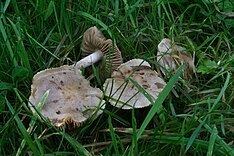Kingdom Fungi Class Agaricomycetes | Division Basidiomycota Order Agaricales Rank Species | |
 | ||
Similar Hebeloma anthracophilum, Hebeloma laterinum, Helicogloea | ||
Hebeloma gigaspermum is a European species of mushroom in the Hymenogastraceae family.
The species Hebeloma gigaspermum was first described only in 1981 and is externally similar to the much better known Hebeloma sacchariolens (being placed in subsection Sacchariolentia of the genus). It is not uncommon in Northern Europe and until 1981 examples were probably simply considered to be H. sacchariolens.
Like the latter it is a nondescript clay brown or ochre mushroom with somewhat viscid cap, up to about 5 cm (2.0 in) in diameter, and has a strong sweet odour which has been likened to orange blossom or amyl acetate. It is distinguished from H. sacchariolens by
The name gigaspermum means "giant-spored".
The edibility of the mushroom is not known for certain, but Hebeloma contains poisonous species and it is not to be recommended for culinary use.
